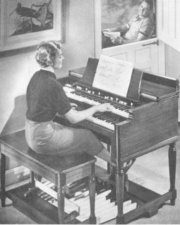Hammond organ
|
|
The Hammond organ is an electronic organ which was designed and built by Laurens Hammond in April 1935. While the Hammond organ was originally sold to churches as a low-cost alternative to the pipe organ, it came to be used for jazz, blues, and to a lesser extent rock music (in the 1960s and 1970s) and gospel music. It was widely used in United States military chapels during and after the Second World War.
In imitation of a pipe organ, with its banks of pipes in multiple registers, the Hammond Organ used additive synthesis of waveforms from harmonic series to generate its sounds. As in Thaddeus Cahill's earlier Telharmonium, the individual waveforms were made by mechanical "tonewheels" which rotated beneath electromagnetic pickups. Although they are generally included in the category of electronic organs, strictly speaking, because the waveforms are produced by mechanical tonewheels rather than electronic oscillators, original Hammond organs are electric rather than electronic organs.
A defining feature of the Hammond organ was the use of "drawbars" to mix the component waveforms in varying ratios. Other features added to Hammond organs included an electromechanical vibrato. The distinctive "key click" that was originally a design flaw rapidly became part of the "Hammond sound", which modern imitations of the Hammond organ faithfully reproduce. Accurate imitation of the Hammond sound with simple electronic circuitry was difficult, because the subtly-changing phase relationships between tonewheels could not be easily replicated.
Speakers made by Leslie were widely used with the Hammond organs, though at first, Leslie was a competing company that Hammond sought to drive out of business. The Leslie speakers had a rotating component that produced a vibrato effect. Soon, the Leslie became a de facto component of any Hammond setup wishing to produce that signature "growling" sound.
The model B-3 was, and still is, the most sought-after model, though the C-3 differs only in cosmetics. Hammonds can be divided into two main groups: the 'Console' models such as the B-3, C-3 or A-100 which have two 61 note manuals and the smaller 'Spinet' models that have two 44 note manuals such as the L-100 and the M-100. Most Hammond organs do not have a full AGO pedalboard, something that was done originally for cost and size reasons.
It is worth noting that not all Hammonds were of the design described above i.e. using tonewheels and drawbars, these are regarded as the 'real Hammonds'. However, the Hammond company produced a number of cheaper organs which used the simpler electronic way of producing sound such as the model J100. These instruments do not have the distinctive characterful 'Hammond sound'.
Modern digital signal processing and sampling technologies now allow extremely accurate imitation of the original Hammond sound, and a variety of electronic organs and synthesizers now provide accurate Hammond emulations. Nevertheless, original electromechanical Hammond organs are prized for their look and feel, and are still much in demand by performers.
References
A very informative book on the Hammond is The Hammond Organ: Beauty in the B, Mark Vail, pub Miller Freeman 1997. (238 pages) ISBN 0879304596.
Notable Hammond organ players
- Gregg Allman
- Brian Auger
- Ena Baga
- Rob Collins
- Wild Bill Davis
- Barbara Dennerlein
- Joey DeFrancesco
- Bill Doggett
- Charles Earland
- Ian Anderson
- Keith Emerson
- Larry Goldings
- Ken Hensley
- Richard "Groove" Holmes
- John Hondorp
- Booker T. Jones
- Charles Kynard
- Eddie Landsberg
- Jon Lord
- Pete Mazich
- Page McConnell (also a famous user of the Leslie)
- "Brother" Jack McDuff
- Jimmy McGriff
- Goldy McJohn
- John Medeski
- Brent Mydland
- Don Patterson
- Big John Patton
- Roy Phillips
- Billy Preston
- Don Pullen
- Freddie Roach
- Melvin Rhyne
- Merl Saunders
- Rhoda Scott
- Shirley Scott
- Paul Shaffer
- Ethel Smith
- Jimmy Smith
- Dr. Lonnie Smith
- Sly Stone
- Rick Wakeman
- Dan Wall
- Robert Walter
- Adam Willby
- Baby Face Willette
- Reuben Wilson
- Steve Winwood
- Rick Wright
- Klaus Wunderlich
- Larry Young
- Eddy Louiss
External links
- obsolete.com article on the Hammond Organ (http://www.obsolete.com/120_years/machines/hammond/)
- Hammond C3 (http://boldt.us/things/music/keys/hammond-c3-organ-with-leslie.html) with Leslie photo gallery.
- The HammondWiki (http://www.dairiki.org/HammondWiki/HammondWiki) — Note: the HammondWiki material is licensed under the OPL, which is incompatible with the GFDL, and so cannot be copied here, except by the original contributors of that material.

